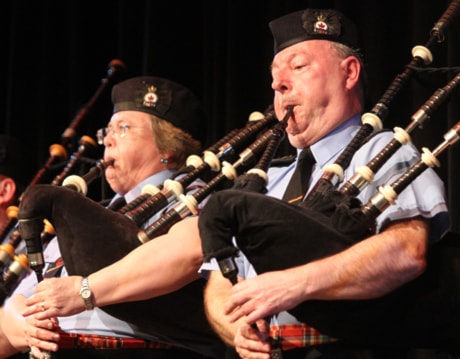It was a chance to look at the past and the future of the Canadian Navy during a ceremony held at the Memorial Centre on Sunday night that drew around 200 people to celebrate the Canadian Naval Centennial.
“Canada has a proud seagoing heritage and from the time the first Europeans set foot on our soil right up to this new century the sea plays an integral part in the story of Canada,” Lt.-Cmdr. Earle Shirley, with the Canadian Navy, told the audience on Sunday night.
Shirley said while some may wonder, while living in Red Deer and more than 1,000 kms from the nearest ocean, surrounded by mountains and prairies, why a navy is necessary.
He explained that Canada has the largest coastline in the world and 90 per cent of non-U.S. trade travels by sea, including coal from this part of the country, which travels by rail and then ocean. The Canadian Navy has more than 30 combatant vessels to protect the country’s coast.
Although Red Deer is landlocked it is one of more than 300 communities that became namesakes to vessels built during the Second World War. The Bangor-class minesweeper, the HMCS Red Deer, was built in 1941.
Shirley has a special connection to the vessel because his father Kenneth Frederick Shirley served on the ship and he said stories of his father’s time there helped encourage him to join the Canadian Navy.
Red Deer Historian Michael Dawe spoke about the history of the Canadian Navy on Sunday night. He said in 1910 the Naval Service of Canada was created, later called the Royal Canadian Navy and now the Canadian Forces Maritime Command. The navy started with one ship named the HMCS Rainbow, which was stationed on the west coast, and then added the HMCS Niobe, which was stationed in Halifax.
Dawe said although Red Deer and Central Alberta are a landlocked part of the country some two dozen young men served in the Royal Canadian Navy during the First Great War, later known as the First World War. The navy expanded in the 1930s, leading up to the Second World War. By the end of which Canada had well over 300 fighting ships and 90,000 personnel in service, many of them young men and women from the Prairies.
“This nation came to have the third largest navy in the world second only to the United States and Great Britain, but second to none in terms of heroism and achievement,” Dawe said.
On Sunday audience members were greeted by the next generation, as Red Deer Sea Cadets 126 met them at the door.
The first part of the ceremony, which was presented by the City of Red Deer, the Canadian Navy and the Royal Canadian Legion Branch # 35, showcased the Red Deer Legion Pipe Band, the Red Deer Royals Concert Band, with director Rob Goring, and the Navy Band from HMCS Tecumseth, with director Chief Petty Officer, 2nd Class Gord Langley.
sobrien@www.reddeeradvocate.com
